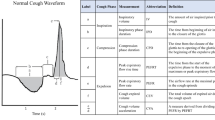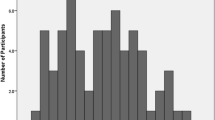Abstract
Aspiration pneumonia is a common cause of death in people with Parkinson’s disease (PD). Dysfunctional swallowing occurs in the majority of people with PD, and research has shown that cough function is also impaired. Previous studies suggest that testing reflex cough by having participants inhale a cough-inducing stimulus through a nebulizer may be a reliable indicator of swallowing dysfunction, or dysphagia. The primary goal of this study was to determine the cough response to two different cough-inducing stimuli in people with and without PD. The second goal of this study was to compare the cough response to the two different stimuli in people with PD, with and without swallowing dysfunction. Seventy adults (49 healthy and 21 with PD) participated in the study. Aerosolized water (fog) and 200 μM capsaicin were used to induce cough. Each substance was placed in a small, hand-held nebulizer, and presented to the participant. Each cough stimulus was presented three times. The total number of coughs produced to each stimulus trial was recorded. All participants coughed more to capsaicin versus fog (p < 0.001). A categorical ‘responder’ and ‘non-responder’ variable for the fog stimulus, defined as whether or not the participant coughed at least two times to two of three presentations of the stimulus, yields sensitivity of 77.8 % and a specificity of 90.9 % for identifying PD participants with and without dysphagia. The data show a differential response of the PD participants to the capsaicin versus fog stimuli. Clinically, this finding may allow for earlier identification of people with PD who are in need of a swallowing evaluation. As well, there are implications for the neural control of cough in this patient population.




Similar content being viewed by others
References
Hegland KW, Pitts T, Bolser DC, Davenport PW. Urge to cough with voluntary suppression following mechanical pharyngeal stimulation. Bratisl Lek Listy. 2011;112:109–14.
Hammer MJ, Murphy CA, Abrams TM. Airway somatosensory deficits and dysphagia in Parkinson’s disease. J Parkinsons Dis. 2013;3:39–44.
Fontana GA, Pantaleo T, Lavorini F, Benvenuti F, Gangemi S. Defective motor control of coughing in Parkinson’s disease. Am J Respir Crit Care Med. 1998;158:458–64.
Dicpinigaitis PV. Short- and long-term reproducibility of capsaicin cough challenge testing. Pulm Pharmacol Ther. 2003;16:61–5.
Davenport Bolser DC, Vickroy T, Berry RB, Martin AD, et al. The effect of codeine on the Urge-to-Cough response to inhaled capsaicin. Pulm Pharmacol Ther. 2007;20:338–46.
Hegland KW, Bolser DC, Davenport PW. Volitional control of reflex cough. J Appl Physiol (1985). 2012;113:39–46.
Yamanda S, Ebihara S, Ebihara T, Yamasaki M, Asamura T, et al. Impaired urge-to-cough in elderly patients with aspiration pneumonia. Cough. 2008;4:11.
Leow LP, Beckert L, Anderson T, Huckabee ML. Changes in chemosensitivity and mechanosensitivity in aging and Parkinson’s disease. Dysphagia. 2012;27:106–14.
Ebihara S, Saito H, Kanda A, Nakajoh M, Takahashi H, et al. Impaired efficacy of cough in patients with Parkinson disease. Chest. 2003;124:1009–15.
Addington WR, Stephens RE, Gilliland K, Rodriguez M. Assessing the laryngeal cough reflex and the risk of developing pneumonia after stroke. Arch Phys Med Rehabil. 1999;80:150–4.
Lee SC, Kang SW, Kim MT, Kim YK, Chang WH, et al. Correlation between voluntary cough and laryngeal cough reflex flows in patients with traumatic brain injury. Arch Phys Med Rehabil. 2013;94:1580–3.
Miles A, Moore S, McFarlane M, Lee F, Allen J, et al. Comparison of cough reflex test against instrumental assessment of aspiration. Physiol Behav. 2013;118:25–31.
Fall PA, Saleh A, Fredrickson M, Olsson JE, Granerus AK. Survival time, mortality, and cause of death in elderly patients with Parkinson’s disease: a 9-year follow-up. Mov Disord. 2003;18:1312–6.
Fernandez HH, Lapane KL. Predictors of mortality among nursing home residents with a diagnosis of Parkinson’s disease. Med Sci Monit. 2002;8:CR241–6.
Chaudhuri KR, Prieto-Jurcynska C, Naidu Y, Mitra T, Frades-Payo B, et al. The nondeclaration of nonmotor symptoms of Parkinson’s disease to health care professionals: an international study using the nonmotor symptoms questionnaire. Mov Disord. 2010;25:704–9.
Mari F, Matei M, Ceravolo MG, Pisani A, Montesi A, et al. Predictive value of clinical indices in detecting aspiration in patients with neurological disorders. J Neurol Neurosurg Psychiatry. 1997;63:456–60.
Ali GN, Wallace KL, Schwartz R, DeCarle DJ, Zagami AS, et al. Mechanisms of oral-pharyngeal dysphagia in patients with Parkinson’s disease. Gastroenterology. 1996;110:383–92.
Pitts T, Bolser D, Rosenbek J, Troche M, Sapienza C. Voluntary cough production and swallow dysfunction in Parkinson’s disease. Dysphagia. 2008;23:297–301.
Pitts T, Bolser D, Rosenbek J, Troche M, Okun MS, et al. Impact of expiratory muscle strength training on voluntary cough and swallow function in Parkinson disease. Chest. 2009;135:1301–8.
Rosenbek JC, Robbins JA, Roecker EB, Coyle JL, Wood JL. A penetration-aspiration scale. Dysphagia. 1996;11:93–8.
Davenport Vovk A, Duke RK, Bolser DC, Robertson E. The urge-to-cough and cough motor response modulation by the central effects of nicotine. Pulm Pharmacol Ther. 2009;22:82–9.
Troche MS, Brandimore AE, Godoy J, Hegland KW. A framework for understanding shared substrates of airway protection. J Appl Oral Sci. 2014;22:251–60.
Eccles R. Central mechanisms IV: conscious control of cough and the placebo effect. Handb Exp Pharmacol. 2009;. doi:10.1007/978-3-540-79842-2_12.
Davenport PW. Clinical cough I: the urge-to-cough: a respiratory sensation. Handb Exp Pharmacol. 2009;. doi:10.1007/978-3-540-79842-2_13.
Troche MS, Brandimore AE, Okun MS, Davenport PW, Hegland KW. Decreased cough sensitivity and aspiration in Parkinson’s disease. Chest. 2014;146(5):1294–9.
Acknowledgments
The authors would like to thank the participants and their families.
Author information
Authors and Affiliations
Corresponding author
Ethics declarations
Conflict of interest
Dr. Hegland reports no disclosures related to this study. Dr. Hegland’s work is supported in part by the American Heart Association and BAE defense systems. Dr. Troche reports no disclosures or conflicts of interest related to this work. Ms. Brandimore reports no disclosures related to this study. Ms. Brandimore’s work is supported in part by a pre-doctoral fellowship through the Department of Veterans Affairs. Dr. Davenport reports no disclosures related to this study. Dr. Davenport’s research is supported by NIH and BAE defense systems. He also has financial interest in Aspire Products, LLC. Dr. Okun reports no disclosures related to this study. Dr. Okun serves as a consultant for the National Parkinson Foundation, and has received research grants from NIH, NPF, the Michael J. Fox Foundation, the Parkinson Alliance, Smallwood Foundation, the Bachmann-Strauss Foundation, the Tourette Syndrome Association, and the UF Foundation. Dr. Okun has previously received honoraria, but in the past > 36 months has received no support from industry. Dr. Okun has received royalties for publications with Demos, Manson, Amazon, and Cambridge (movement disorders books). Dr. Okun is an associate editor for New England Journal of Medicine Journal Watch Neurology. Dr. Okun has participated in CME activities on movement disorders in the last 36 months sponsored by PeerView, Prime, and by Vanderbilt University. The institution and not Dr. Okun receives grants from Medtronic and ANS/St. Jude, and the PI has no financial interest in these grants. Dr. Okun has participated as a site PI and/or co-I for several NIH, foundation, and industry sponsored trials over the years but has not received honoraria.
Rights and permissions
About this article
Cite this article
Hegland, K.W., Troche, M.S., Brandimore, A. et al. Comparison of Two Methods for Inducing Reflex Cough in Patients With Parkinson’s Disease, With and Without Dysphagia. Dysphagia 31, 66–73 (2016). https://doi.org/10.1007/s00455-015-9659-5
Received:
Accepted:
Published:
Issue Date:
DOI: https://doi.org/10.1007/s00455-015-9659-5




